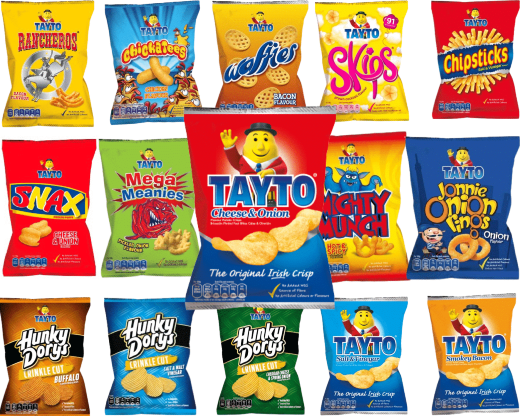Key Takeaways
- Irish crisps are deeply tied to national identity and nostalgia.
- Tayto, King, Keogh’s, and Hunky Dorys dominate the domestic crisp market.
- Bikers crisps are undergoing a social media-driven resurgence.
- The Tayto chocolate bar blends novelty with viral success.
- Irish crisps are gaining popularity in England and among global diaspora.
- E-commerce and TikTok trends are expanding snack exports.
At Dublin Airport’s Terminal 2, just past the Guinness shop and shelves of Jameson minis, sits an unlikely crowd-pleaser: a wall stacked with bright packets of Tayto crisps. Tourists snap photos. Locals stock up. Airport staff sneak bites on break. These aren’t just snacks — they’re a cultural currency.
Crisps in Ireland are more than crunchy sides to a pint. They’re markers of memory, identity, even diaspora longing. And in 2025, they’re also a booming niche in the global snack economy — driven by TikTok virality, digital nostalgia, and a bold willingness to mess with flavor orthodoxy.
A Nation of Crisp Loyalists
Tayto, the founding father of Irish crisps, introduced the world’s first cheese and onion flavor in 1954. That alchemy remains a standard, echoed by King Crisps (Tayto-owned but stronger in seasoning) and Hunky Dorys, known for its steak and buffalo twists. Premium players like Keogh’s and O’Donnells add artisanal flair, trading on provenance and hand-cooked cachet.
“Crisps are part of how Irish people understand their own food culture,” says Dr. Aoife O’Leary, a food historian at University College Cork. “They’re not just snacks — they’re emotionally charged, like Barry’s vs Lyons tea.”
Indeed, Tayto’s Mr. Tayto mascot is arguably more recognisable than any Irish political figure. Tayto Park, recently rebranded as Emerald Park, still carries echoes of its snack origins and remains a symbol of Irish snack branding.
Bikers and the TikTok Nostalgia Loop
If Tayto is the establishment, Bikers crisps are the rebellious cousin. Cheap, spicy, and once a lunchtime staple, they faded from shelves in the early 2010s. But in recent years, “spicy Bikers crisps” has surged 30% in Google searches. TikTokers film reactions to the tongue-tingling coating. Instagram snack accounts list Bikers as “extinct legends.”
“The demand is irrational,” says James Curley, a food importer in Manchester. “We get calls weekly from Irish mums in the UK asking if we have spicy Bikers for care packages.”
This nostalgia commerce — familiar from Pokémon cards and Y2K fashion — now extends to corn snacks and tuck shop classics. Unlike global brands, these crisps have no real presence outside Ireland, boosting their underground appeal.
Tayto Chocolate: Culinary Heresy Meets Viral Triumph
The Tayto chocolate bar, an audacious mash-up of cheese and onion crisps embedded in milk chocolate, first appeared as a joke. Then it sold out.
Critics called it “disgusting.” Foodies queued anyway. Gen Z, raised on oddball taste combos and viral snack hacks, embraced it fully. “It’s terrible and amazing,” said one YouTube reviewer with 2 million views. “You hate yourself — and then you take another bite.”
The bar’s success was fuelled by TikTok challenges and the allure of the bizarre. Tayto has since teased new variants, including a Salt & Vinegar edition and a rumored “limited run” Guinness crisp bar.
From Birmingham to Boston: The Irish Snack Diaspora
Ireland’s food exports tend to skew towards beef and butter, but crisps — and their novelty spinoffs — are gaining ground. In UK cities with high Irish populations like Birmingham, demand for Tayto crisps and spicy Bikers has risen notably. Google search data shows sharp year-over-year increases for terms like “Tayto crisps England,” “Irish food shop Birmingham,” and “Irish supermarket snacks.”
Online retailers such as NetCrisps and Amazon UK now stock curated bundles of Irish snacks. Specialty importers ship Tayto to Boston and New York, often as part of a Taste of Ireland hamper timed for St. Patrick’s Day or gift-giving seasons.
“The diaspora drives this,” says Elaine McGrath, an export consultant based in Louth. “People want a taste of home, but also something Instagrammable.”
Why Irish Crisps Hit Differently
| Feature | Irish Crisps | UK/Global Brands |
|---|---|---|
| Flavor Intensity | Bold, especially Cheese & Onion | Milder, often less aggressive |
| Texture | Often thicker or ridged | Uniform and thin |
| Packaging | Regional pride, vintage aesthetics | Modern but less nostalgic |
| Limited Editions | Risky, bold (Tayto chocolate) | Rare, more focus-group tested |
The Irish crisp aesthetic prizes excess — strong seasoning, odd pairings, bold risks. That stands in contrast to the risk-averse uniformity of global brands. “They’re not trying to please everyone,” says O’Leary. “They’re trying to taste like something real.”
Crisp Hampers and Cultural Gifting
Retailers are catching on. Duty-Free stores now offer “Taste of Ireland” hampers with Tayto, Hunky Dorys, and Keogh’s. Airbnb hosts stock mini packs for guests. And food influencers pitch crisp samplers to audiences in the U.S., Germany, and Australia.
“Crisps are becoming cultural shorthand,” says McGrath. “They say: this is Irish, but also this is fun.”



